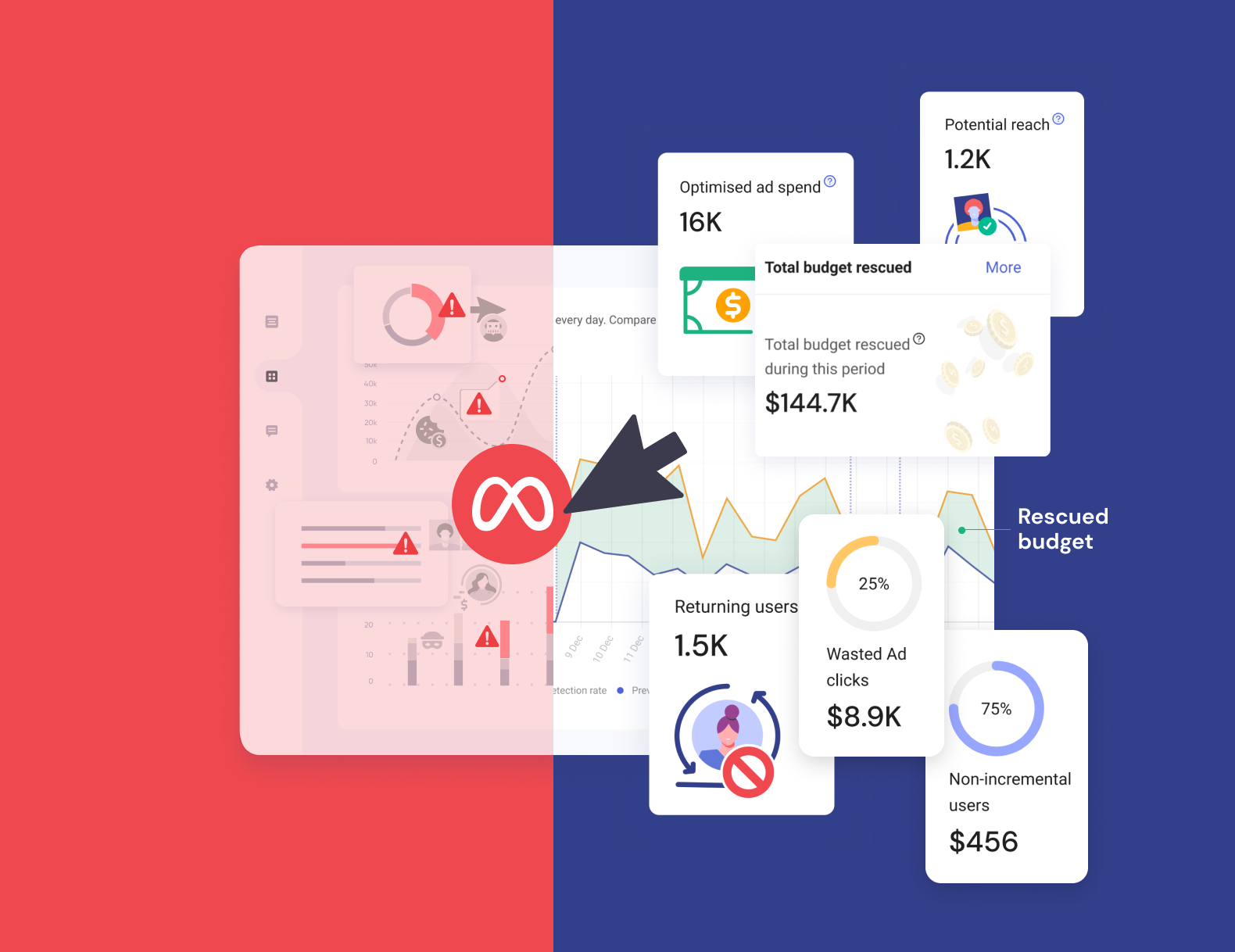Understanding Ad Fraud: How Fraudsters Exploit and Profit from Deceptive Tactics

Click fraud is a silent parasite in digital advertising. It distorts performance data, wastes media budgets, and fuels an underground economy that rewards fake engagement over genuine intent.
For advertisers, the risk is not hypothetical. It is happening right now. Without the right protection, it is draining your ROI, corrupting your optimisation, and putting your campaigns at a competitive disadvantage.
This blog breaks down how click fraud operates, the deceptive tactics behind it, and what you can do to fight back with confidence.
What is click fraud in digital advertising?
Click fraud is the deliberate generation of fake ad interactions to manipulate performance and exhaust budgets. These clicks are not coming from real prospects or customers. They are triggered by bots, click farms, competitors, or bad actors trying to exploit ad platforms for financial gain.
It affects all types of campaigns: Search, Display, Performance Max, App, Video and more. And it is often disguised as legitimate user behaviour, making it difficult to detect without advanced click fraud prevention software.
But this is not just a nuisance. Beneath every fake click is a business model designed to siphon your ad budget and turn deception into profit.
Common tactics used by click fraudsters
Click fraud does not come in one form. It is a layered set of tactics designed to mimic legitimate traffic while driving up costs and distorting results.
1. Click fraud
The most direct approach: generating false clicks on paid ads. This can be done manually (click farms) or automatically (bots and scripts). The goal is simple: drain budgets and make campaigns appear more successful than they are.
2. Impression fraud
Instead of clicks, fraudsters generate inflated ad impressions, often through invisible ads, pixel stuffing, or domain spoofing. The aim is to increase CPM-based revenue without any real user engagement.
3. Affiliate marketing manipulation
Fraudsters fake conversions, form submissions or installs to earn commission. They hijack attribution mechanisms and simulate user journeys that never happened. Advertisers end up paying for outcomes that do not exist.
4. Bot traffic and fake users
Bots are used to mimic real users by clicking, viewing, scrolling and converting, but none of it is genuine. Bot traffic pollutes campaign data, contaminates retargeting pools, and makes optimisation efforts meaningless.
5. Click injection and SDK spoofing
Fraudsters use mobile-specific tactics like click injection or spoofing SDK events to hijack install attribution. These techniques allow them to claim credit for organic installs by simulating click or install events just before a legitimate user downloads an app.
6. Domain spoofing
Fraudsters disguise poor-quality or non-existent websites as premium placements. By masking the true source of traffic, they trick advertisers into overpaying for inventory that has no value.
How fraudsters monetise click fraud
Click fraud is lucrative because ad platforms reward interactions, not intent. Fraudsters understand this and exploit it at scale.
1. Exploiting CPC and CPM models
Whether you are paying per click or per thousand impressions, fraudsters are ready to take advantage. Fake clicks and impressions can be automated and scaled quickly, turning your media budget into their revenue stream.
2. Gaming affiliate and referral links
In affiliate campaigns, fraudsters inject themselves into the attribution path. They use bots or fake traffic to trigger last-click credit or simulate purchases, earning commission without delivering actual value.
One common tactic is cookie stuffing using browser extensions. For example, the Honey extension has been known to fire hidden affiliate clicks through iframes when users search for discount codes. Even if the user visited the site organically, Honey secretly inserts itself as the referrer claiming commission for a sale it didn’t drive.

It’s sneakier than you think and here’s a blog explaining how it works.
3. Hijacking optimisation algorithms
Fraud does not just waste money. It manipulates campaign learning. Platforms like Google Ads rely on engagement signals to optimise delivery. When fake traffic floods your campaigns, algorithms learn from the wrong patterns, reinforcing bad performance.
The impact of click fraud on campaign performance
Click fraud is not just a budget issue. It degrades every aspect of your campaign performance.
1. Budget drain and lost ROI
Every fake click is a wasted dollar. Multiply that across thousands of interactions, and your campaign’s profitability disappears fast. In high-CPC industries like legal, finance or iGaming, even a small percentage of click fraud can mean thousands lost daily.
2. Misleading performance metrics
Fake engagement skews CTR, CPC, bounce rates, and conversion data. This misleads your optimisation decisions. You end up making changes based on corrupted data and chasing the wrong benchmarks.
3. Long-term brand trust damage
Click fraud undermines trust in marketing data. Leadership loses faith in performance teams. Customers may also get exposed to ads via low-quality placements or fraudulent sites, eroding brand equity and credibility.
4. Retargeting waste
When invalid traffic enters your audience pools, you waste even more budget retargeting fake users. Not only are you losing money up front, but you are compounding losses across the funnel.
How to detect click fraud early
The sooner you spot click fraud, the more you can save. But fraud detection requires vigilance and the right tools.
1. Spotting anomalies in traffic reports
Watch for unusual spikes in click volume, sudden surges in traffic from unknown geographies, or repeated visits from the same IPs or devices. These are early signs that something is off.
2. Signs of click/impression abnormalities
Clicks with no page engagement. High impression counts with no viewability. Form fills from suspicious domains. All signs of automated or manipulated activity.
3. Behavioural inconsistencies
Look for patterns such as short session durations, no scroll depth, zero interaction with CTAs or rapid bounce backs. Real users behave with intent. Bots and fraud do not.
Tools vs Manual review
Manual review can catch basic issues, but it is not scalable. Click fraud prevention software like TrafficGuard uses real-time detection, automation, and historical analysis to block threats before damage is done.
Platforms like Google Ads and Meta have built-in fraud filters, but these only go so far. Their solutions often focus on invalid traffic at the network level, not what happens post-click. Sophisticated fraud often slips through the cracks.
How TrafficGuard protects against click fraud
TrafficGuard provides enterprise-grade protection that prevents invalid traffic before it eats into your ad spend. Here's how it works:
1. Real-time blocking and detection
TrafficGuard monitors every click, impression, and conversion in real time, blocking fraudulent traffic before it reaches your campaign budget. No delay. No manual intervention needed.
2. Click frequency management
Our platform detects and blocks repeated clicks from the same user, IP or device. Whether it is a bot or a competitor, we shut it down before it causes harm.
3. Unified dashboard and analytics
See exactly where your budget is going and where it is being wasted. TrafficGuard’s dashboard gives you complete visibility over traffic sources, anomalies, and invalid traffic breakdowns, so you can optimise with confidence.
4. Attribution validation
TrafficGuard ensures only real engagement gets credited. We validate clicks and conversions before they are counted, giving you confidence that reported outcomes are genuinely tied to user intent.
Final thoughts
Click fraud lurks in every campaign. It is sneaky, it is expensive, and it is a silent assassin of your ad spend.
But here is the good news: you are not defenceless. When armed with the right tools, insights, and partners like TrafficGuard, you can turn the tide. Understand the threat, shield your campaigns, and reclaim control of your ad budget.
If you are ready to take the next step, we are here to help. Let’s make every click count for real.
FAQ & key takeaways
- What is click fraud and how does it work?
Click fraud is the act of generating fake ad interactions to waste advertiser budgets and profit through CPC or affiliate models. It is often carried out through bots, click farms or fraudulent affiliates.
- What are the signs I might be a victim of click fraud?
Unusual spikes in traffic, low engagement after clicks, and inflated metrics with no conversions are key red flags. Repeated clicks from the same IPs or locations are also a giveaway.
- What is the true cost of click fraud?
Beyond budget loss, click fraud damages your reporting, retargeting, campaign learning, and overall marketing credibility. It leads to misinformed decisions and long-term performance degradation.
- How does TrafficGuard help prevent click fraud?
TrafficGuard blocks fraudulent clicks in real time, tracks every interaction with advanced algorithms, and provides transparent analytics so advertisers can stay ahead of the threat.
Get started - it's free
You can set up a TrafficGuard account in minutes, so we’ll be protecting your campaigns before you can say ‘sky-high ROI’.
Subscribe
Subscribe now to get all the latest news and insights on digital advertising, machine learning and ad fraud.








